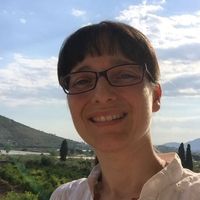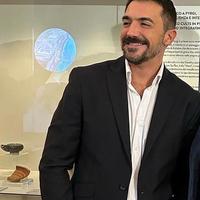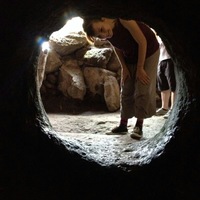Conference Presentations by Carla Tulini
Papers by Carla Tulini

The 2021-2023 excavation campaigns have provided more information about Pyrgi’s overall urban ass... more The 2021-2023 excavation campaigns have provided more information about Pyrgi’s overall urban asset, focussing the relation between the sacred district, the settlement area and the harbour.
In the settlement area, fieldwork has mainly addressed the Ceremonial Quarter at the intersection between the urban track of the Caere-Pyrgi road and a pebbled road leading to the oriental port-basin. This includes
public buildings that have played representative, political and economic functions from the middle 6th century BC at least. Excavation has confirmed the performance of metallurgic activities and connected ritual
acts in the plot N of the pebbled road, as already shown by the metal offerings focussing the gray tuff container included in room A; noteworthy is the recovery of two leaden counterpoise weights of lever scales.
The building complex S of the pebbled road has certainly played a public function, as highlighted by the decorated roofs and the many ritual acts associated with any building intervention; its peculiar late-archaic
plan matches the model of the transversal porticoed houses- well documented by Caeretan funerary architecture, and the atrium houses. Excavation is outlining the archaic asset of the building, also documented by the recovery of architectural terracottas; extremely interesting is a huge polycrome mud-brick basement maybe connected with some ritual structure, that falls in the underground of the portico. In general, the
ritual deposition of local and imported amphoras and of stone anchors, together with the offering of phoenician lamps, well highlights the attendance of the building by (foreign) merchants and the strict connection with the commercial sphere.
As far as the Monumental Sanctuary, the excavation area now includes not only the entrance area but also a wide strip along temple A and its frontal terrace. Fieldwork has definitively confirmed the presence of a road
that stems from the Caere-Pyrgi track and runs parallel with Temple A, marking the limit of the Sanctuary to the N in spite of the lack of evidence of a proper témenos wall. Another important new acquisition is the
evidence of a dry masonry rectangular archaic building-maybe a shrine, that was intercepted by Temple’s foundation cut, whereas the recovery of a ashlar masonry base included in the frontal terrace provides further
information about the location of altars or donations in the sacred area.
As regards the overall asset of the maritime settlements, important new data have been gathered through the documentation and collection of pottery shards from the houses that are being dismantled by the sea erosion and through the underwater survey performed in 2023 in front of the excavation areas.
MOSTRE • EMILIA-ROMAGNA 44 a r c h e o.

The city of Veii presents a particularly developed and complex sacred topography, which remains o... more The city of Veii presents a particularly developed and complex sacred topography, which remains only partly understood. In 2014, Giovanni Colonna published a first comprehensive picture of the site: eleven sacred areas dot the plateau and the suburban area.
This contribution aims to investigate the dynamics by which the production activities related to the sphere of the sacred were organised.
The decision has been made to focus on the later, moulded productions, for which Veii is undoubtedly an important case study due to the quantity of objects that have been retrieved. In particular, specific products occur in high quantities and were distributed contemporaneously in various sacred areas in the city. It is therefore necessary to reflect on the organisation of the various ateliers and on the mechanisms by which their products were distributed to the different sacred areas.
In order to clarify some of these production dynamics, Mattia Bischeri and Carla Tulini have considered the case of the lyricine Apollo, adopting a morphometric approach.
This analysis would seem to open up a new perspective. Several “sizes” of the same objects were identified, with a calibrated percentage reduction of clay from one size to another. While this aspect may be a valid criterion for the distinction of the “generation” transition in the artisanal practice, it could also validate the idea of the existence of a standardised “sampler”, intentionally articulated by sizes within the same type. In other words, larger and more carefully retouched votive offerings may have had a higher intrinsic value, determined by the amount of raw material used and above all by the added value of the labour, thus responding not only to different religious practices, but perhaps also to variable “market” demands
Edited books by Carla Tulini










Uploads
Conference Presentations by Carla Tulini
Papers by Carla Tulini
In the settlement area, fieldwork has mainly addressed the Ceremonial Quarter at the intersection between the urban track of the Caere-Pyrgi road and a pebbled road leading to the oriental port-basin. This includes
public buildings that have played representative, political and economic functions from the middle 6th century BC at least. Excavation has confirmed the performance of metallurgic activities and connected ritual
acts in the plot N of the pebbled road, as already shown by the metal offerings focussing the gray tuff container included in room A; noteworthy is the recovery of two leaden counterpoise weights of lever scales.
The building complex S of the pebbled road has certainly played a public function, as highlighted by the decorated roofs and the many ritual acts associated with any building intervention; its peculiar late-archaic
plan matches the model of the transversal porticoed houses- well documented by Caeretan funerary architecture, and the atrium houses. Excavation is outlining the archaic asset of the building, also documented by the recovery of architectural terracottas; extremely interesting is a huge polycrome mud-brick basement maybe connected with some ritual structure, that falls in the underground of the portico. In general, the
ritual deposition of local and imported amphoras and of stone anchors, together with the offering of phoenician lamps, well highlights the attendance of the building by (foreign) merchants and the strict connection with the commercial sphere.
As far as the Monumental Sanctuary, the excavation area now includes not only the entrance area but also a wide strip along temple A and its frontal terrace. Fieldwork has definitively confirmed the presence of a road
that stems from the Caere-Pyrgi track and runs parallel with Temple A, marking the limit of the Sanctuary to the N in spite of the lack of evidence of a proper témenos wall. Another important new acquisition is the
evidence of a dry masonry rectangular archaic building-maybe a shrine, that was intercepted by Temple’s foundation cut, whereas the recovery of a ashlar masonry base included in the frontal terrace provides further
information about the location of altars or donations in the sacred area.
As regards the overall asset of the maritime settlements, important new data have been gathered through the documentation and collection of pottery shards from the houses that are being dismantled by the sea erosion and through the underwater survey performed in 2023 in front of the excavation areas.
This contribution aims to investigate the dynamics by which the production activities related to the sphere of the sacred were organised.
The decision has been made to focus on the later, moulded productions, for which Veii is undoubtedly an important case study due to the quantity of objects that have been retrieved. In particular, specific products occur in high quantities and were distributed contemporaneously in various sacred areas in the city. It is therefore necessary to reflect on the organisation of the various ateliers and on the mechanisms by which their products were distributed to the different sacred areas.
In order to clarify some of these production dynamics, Mattia Bischeri and Carla Tulini have considered the case of the lyricine Apollo, adopting a morphometric approach.
This analysis would seem to open up a new perspective. Several “sizes” of the same objects were identified, with a calibrated percentage reduction of clay from one size to another. While this aspect may be a valid criterion for the distinction of the “generation” transition in the artisanal practice, it could also validate the idea of the existence of a standardised “sampler”, intentionally articulated by sizes within the same type. In other words, larger and more carefully retouched votive offerings may have had a higher intrinsic value, determined by the amount of raw material used and above all by the added value of the labour, thus responding not only to different religious practices, but perhaps also to variable “market” demands
Edited books by Carla Tulini
In the settlement area, fieldwork has mainly addressed the Ceremonial Quarter at the intersection between the urban track of the Caere-Pyrgi road and a pebbled road leading to the oriental port-basin. This includes
public buildings that have played representative, political and economic functions from the middle 6th century BC at least. Excavation has confirmed the performance of metallurgic activities and connected ritual
acts in the plot N of the pebbled road, as already shown by the metal offerings focussing the gray tuff container included in room A; noteworthy is the recovery of two leaden counterpoise weights of lever scales.
The building complex S of the pebbled road has certainly played a public function, as highlighted by the decorated roofs and the many ritual acts associated with any building intervention; its peculiar late-archaic
plan matches the model of the transversal porticoed houses- well documented by Caeretan funerary architecture, and the atrium houses. Excavation is outlining the archaic asset of the building, also documented by the recovery of architectural terracottas; extremely interesting is a huge polycrome mud-brick basement maybe connected with some ritual structure, that falls in the underground of the portico. In general, the
ritual deposition of local and imported amphoras and of stone anchors, together with the offering of phoenician lamps, well highlights the attendance of the building by (foreign) merchants and the strict connection with the commercial sphere.
As far as the Monumental Sanctuary, the excavation area now includes not only the entrance area but also a wide strip along temple A and its frontal terrace. Fieldwork has definitively confirmed the presence of a road
that stems from the Caere-Pyrgi track and runs parallel with Temple A, marking the limit of the Sanctuary to the N in spite of the lack of evidence of a proper témenos wall. Another important new acquisition is the
evidence of a dry masonry rectangular archaic building-maybe a shrine, that was intercepted by Temple’s foundation cut, whereas the recovery of a ashlar masonry base included in the frontal terrace provides further
information about the location of altars or donations in the sacred area.
As regards the overall asset of the maritime settlements, important new data have been gathered through the documentation and collection of pottery shards from the houses that are being dismantled by the sea erosion and through the underwater survey performed in 2023 in front of the excavation areas.
This contribution aims to investigate the dynamics by which the production activities related to the sphere of the sacred were organised.
The decision has been made to focus on the later, moulded productions, for which Veii is undoubtedly an important case study due to the quantity of objects that have been retrieved. In particular, specific products occur in high quantities and were distributed contemporaneously in various sacred areas in the city. It is therefore necessary to reflect on the organisation of the various ateliers and on the mechanisms by which their products were distributed to the different sacred areas.
In order to clarify some of these production dynamics, Mattia Bischeri and Carla Tulini have considered the case of the lyricine Apollo, adopting a morphometric approach.
This analysis would seem to open up a new perspective. Several “sizes” of the same objects were identified, with a calibrated percentage reduction of clay from one size to another. While this aspect may be a valid criterion for the distinction of the “generation” transition in the artisanal practice, it could also validate the idea of the existence of a standardised “sampler”, intentionally articulated by sizes within the same type. In other words, larger and more carefully retouched votive offerings may have had a higher intrinsic value, determined by the amount of raw material used and above all by the added value of the labour, thus responding not only to different religious practices, but perhaps also to variable “market” demands